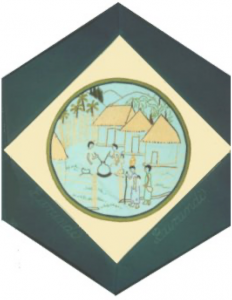Burundi

The Block
The lush trees and green hills stitched on a blue background portray the landscape of Burundi. Using a combination of long and short pale yellow filling stitches, Mathilde Nduwimana, vividly replicates the texture of banana leaves and straw used to thatch the roofs of typical Burundi homes. Reflecting the country’s strong sense of community, women gather at the village centre to work together pounding grain while visitors approach the village to partake of Burundian’s legendary hospitality. Drinking impeke, a home-made sorghum beer very low in alcohol, is a common practice in the country. This drink is sold in markets from big jugs such as the one depicted in the block. When people gather, each person dips their straw in one large communal jug, thus symbolizing their unity.
Cultural Profile
Burundi, one of Africa’s smallest countries, is a landlocked nation situated close to the Equator. It is known as “The Heart of Africa” because of its shape and position on the continent. Burundi’s Lake Tanganyika is home to several species of fish that are not found anywhere else in the world. The source of the world’s longest river, the Nile, is located in southern Burundi.
Kirundi and French are the official languages, while Swahili is spoken in some areas. The main ethnic groups are the Hutu and the Tutsi. The Twa (Pygmies), believed to be the original inhabitants of Burundi, make up 1% of the population. They are known for their fine dark glossy pottery, which they often sell to provide their families with an income.
Children are very important to Burundian families who have a Kirundi saying that translates “You cannot say you like me, if you do not like my children.” Elders are also treated with great respect, as they are seen as essential to the transmission of knowledge. Children are taught at a young age that it is their duty to care for them. Burundian culture is passed from generation to generation through oral traditions. Stories, sayings and lessons convey practical information for living, as well as values and a sense of life’s purpose.
Burundians are known for their woven blankets and wood carvings as well as their baskets. Basket weaving is a skill girls are taught at an early age so that, as women, they are able to produce papyrus baskets and lids displaying beautiful geometrical designs. These baskets are used to store various items, but mostly food. Every Burundian home keeps an extra supply in case visitors should come.
Traditional musical instruments of Burundi include the inanga, a string instrument of 6 to 9 strings stretched over a slightly curved wooden soundboard. The inanga is used during rituals as well as to accompany songs about historical events or personal experiences. The singer sings in a very low voice, sometimes even whispering his lyrics so as not to overpower the delicate sound of the instrument. Drums are sacred and drummers are considered to be important representatives of musical traditions. The ‘Royal Drummers of Burundi,’ a 14-member troupe, is renowned around the world for its energetic and uplifting performances using the ingomas, the semi-divine drums of Burundi. Traditional dances are performed by both men and women — though in separate groups — varying the movements and rhythms according to what is being celebrated.
Burundians have been coming to Canada since 1974 to further their education, find employment, or to join family members. Many have also come as refugees from a devastating civil war. In Canada’s 2011 census over 7,300 people declared themselves to be of Burundian ancestry. Burundians continue their practice of supporting one another as a community. They also take part in various activities to keep their traditions alive in Canada. The Ishaka Dance Group of Ottawa, for example, performs the traditional dances of Burundi.
Sponsor: Lancaster Optimist Club
